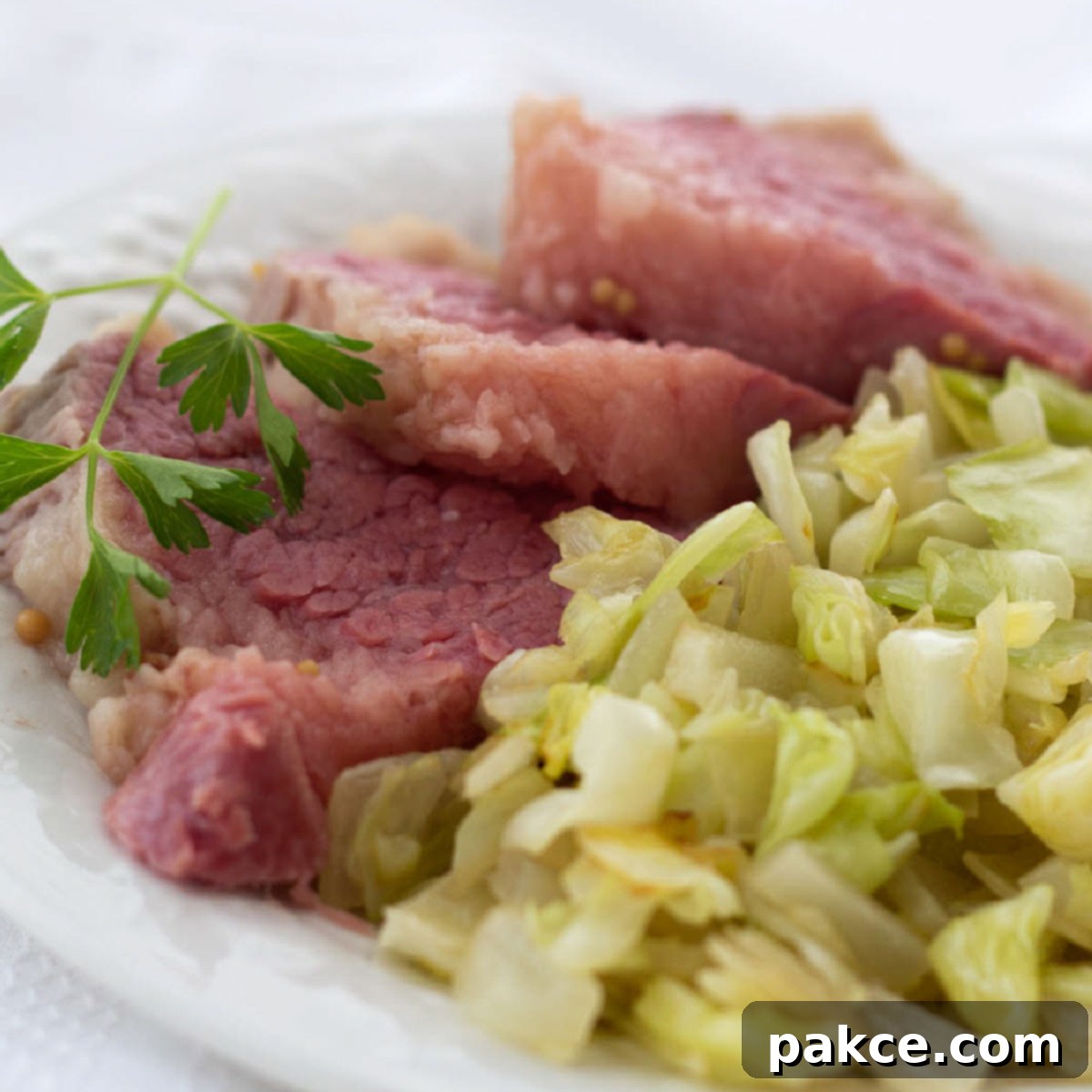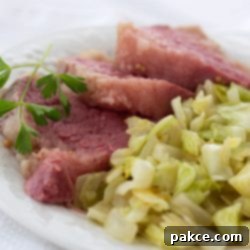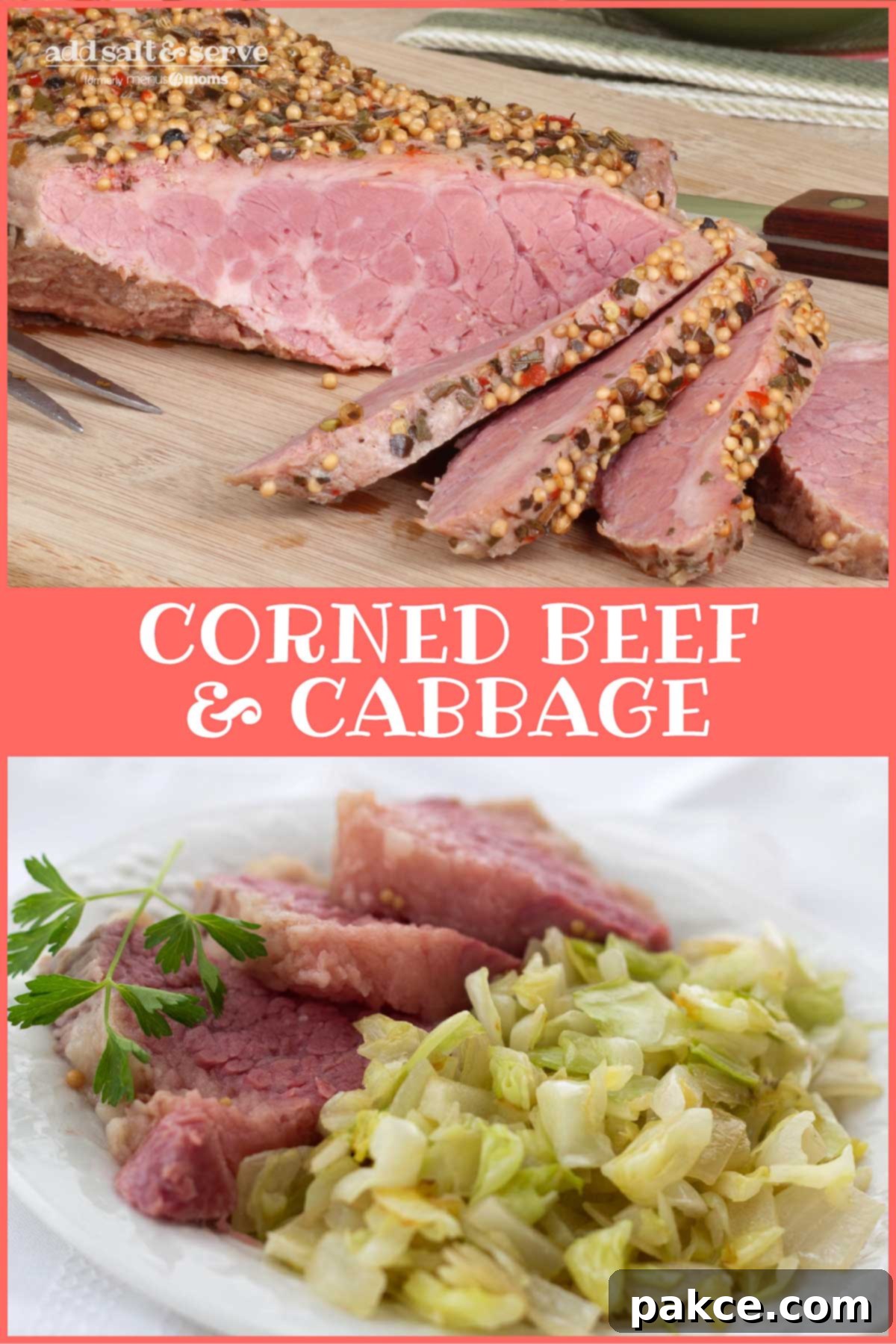Easy & Flavorful Corned Beef and Cabbage: Your Ultimate Stovetop or Slow Cooker Guide
Prepare yourself for a culinary journey with a dish that perfectly balances savory, tender corned beef with crisp-tender cabbage. This classic combination is not just a beloved staple for St. Patrick’s Day celebrations; it’s a comforting, satisfying meal that deserves a spot in your regular rotation. Whether you prefer the traditional stovetop method or the set-it-and-forget-it convenience of a slow cooker, our comprehensive guide will walk you through creating a dish so delicious, you’ll want to make it again and again. Plus, we’ve got you covered for the next day: plan on doubling the recipe because any leftovers make for the most incredible Reuben sandwiches! (And truly, if you don’t double it, you might find there are no leftovers at all – it’s *that* good!)

[feast_advanced_jump_to]
⏲️ Time Needed to Cook Corned Beef and Cabbage
The cooking time for corned beef and cabbage largely depends on your chosen method, but both result in incredibly tender meat and vegetables. For the traditional stovetop method, you’ll need to allow approximately 3 hours of simmering time, plus a little extra for prep. If you opt for the more hands-off crockpot method, plan for a longer cook time of 5-6 hours on high, or even longer on a low setting (up to 8-10 hours). While the slow cooker takes more time, it offers unmatched convenience, allowing you to go about your day while dinner practically cooks itself.
🥘 Simple Ingredients for a Delicious Corned Beef and Cabbage
Making a flavorful corned beef and cabbage dish doesn’t require a long list of exotic ingredients. In fact, its beauty lies in its simplicity. Here’s what you’ll need for this hearty meal:
- Corned Beef Brisket with Spice Packet: The star of the show! Most corned beef briskets come with a small spice packet. This is crucial for developing the characteristic flavor. You’ll typically find two main cuts of brisket: flat cut (leaner, easier to slice uniformly) and point cut (more marbled, falls apart easily). Either works wonderfully for this recipe.
- Chopped Onions: A foundational aromatic that adds depth and sweetness to the broth as the beef cooks. Yellow or white onions are perfect.
- Chopped Cabbage: The ideal counterpart to the rich beef. Green cabbage is most commonly used for its robust texture and mild flavor that holds up well during cooking. Cut it into wedges or large chunks so it doesn’t get too soft.
- Water: To cover the brisket and create the flavorful cooking liquid.
- Optional (but recommended) additions: While not strictly in the basic recipe, many people love to add carrots and potatoes to the pot for a complete one-pot meal, especially towards the end of the cooking process.
📋 Step-by-Step Instructions: Stovetop or Slow Cooker
This versatile corned beef brisket recipe can be perfectly prepared using either the classic stovetop method or the convenient slow cooker. Both methods promise tender, flavorful results – choose the one that best fits your schedule!
For the Stovetop Method (Approx. 3 hours cook time):
- Prepare the Brisket: Begin by placing your corned beef brisket in a large, heavy-bottomed pot or Dutch oven. Ensure the pot is large enough to hold the brisket comfortably and allow it to be fully submerged.
- Add Liquid and Seasoning: Cover the brisket completely with water. Then, open the spice packet that came with your corned beef and sprinkle its contents over the meat and into the water. The spices will infuse the cooking liquid, giving the beef its signature flavor.
- Bring to a Simmer: Place the pot on your stovetop over high heat and bring the contents to a gentle simmer. Once simmering, reduce the heat to low, cover the pot tightly, and maintain a consistent, gentle simmer.
- Cook Until Tender: Allow the brisket to simmer on low for approximately three hours. The beef should become incredibly tender, easily pierced with a fork. To ensure it’s fully cooked and safe to eat, the internal beef temperature should reach at least 160ºF (71ºC) when measured with a meat thermometer.
- Add Vegetables: In the last 15-30 minutes of cooking, add your chopped onions and cabbage to the pot. Continue to cook until the vegetables are tender, but still retain a slight bite.
For the Crockpot (Slow Cooker) Method (Approx. 5-6 hours on high):
- Prepare the Brisket: Place the corned beef brisket directly into your crockpot. Again, ensure it fits well within the slow cooker insert.
- Add Liquid and Seasoning: Cover the brisket with water. Add the spice packet over the meat and into the water.
- Slow Cook: Cover the crockpot and cook on the “high” setting for 5-6 hours. Alternatively, you can cook it on the “low” setting for 8-10 hours. The goal is for the beef to be exceptionally tender, with an internal temperature of at least 160ºF (71ºC).
- Incorporate Vegetables: About an hour before you plan to serve, add the chopped cabbage and onions (and any other root vegetables like potatoes or carrots) to the crockpot. Continue cooking until these vegetables are tender to your liking.
❓ Corned Beef Frequently Asked Questions
Corned beef is a fascinating dish with a rich history and unique characteristics. Here are answers to some of the most common questions about it:
What cut of meat is corned beef made from?
Corned beef is primarily made from beef brisket. Brisket is a boneless cut of beef taken from the breast or lower chest of the cow. It’s a tough cut of meat, rich in connective tissue, which is why slow cooking methods are ideal for breaking down those fibers and achieving that incredibly tender, fall-apart texture. The long, slow cooking process also allows the flavors of the curing and spices to deeply penetrate the meat.
What is corned beef?
Corned beef is essentially a salt-cured beef product. The term “corned” actually refers to the historical practice of using large grains of rock salt, which the English called “kernels” or “corns,” to preserve the meat. This salt curing process, often combined with nitrates, not only preserves the beef but also imparts a distinctive flavor and, if nitrates are used, a characteristic pinkish-red color. The unique taste of corned beef comes from two main processes: the initial salt curing and the additional seasoning from the spice packet during cooking.
Is Corned Beef Irish?
The connection between corned beef and Irish culture, particularly in the U.S., is widely recognized, but its origins are more complex and debated. While people in the U.S. typically associate it with traditional Irish cuisine, especially around St. Patrick’s Day, its history reveals a fascinating transatlantic journey. Ireland did play a significant role in the salt beef industry in the 17th century. This was largely due to its vast cattle industry and the fact that Ireland benefited from a much lower salt tax compared to England. This economic advantage made Irish cured beef a popular export, particularly as sea-based wars increased the demand for preserved meats that could endure long voyages. However, this “corned beef” was primarily for export and generally not a staple for the average Irish household, where bacon and cabbage were more common. By the early 20th century, corned beef became immensely popular among Irish immigrants in the U.S. It was a reasonably priced and readily available alternative to the more expensive bacon of their homeland. They often found a steady, affordable supply of this cured meat from Jewish butchers in American cities, forging the strong cultural link we know today.
(Source)
What is in the spice packet?
The spice packet that accompanies most corned beef briskets is essentially a blend of pickling spices. While the exact contents can vary slightly between brands, common ingredients typically include:
- Bay leaves
- Black peppercorns
- Mustard seeds
- Dill seeds
- Coriander seeds
- Sometimes allspice, cloves, or red pepper flakes are also included for an extra layer of flavor.
These spices are crucial for infusing the beef with its distinctive, aromatic taste during the long cooking process.
Why is my cooked corned beef brown instead of red?
The color of your cooked corned beef is primarily determined by whether nitrates were used during the curing process. If the package of beef you used was cured without nitrates (often labeled as “uncured” or “nitrate-free”), the resulting roast will be a natural brown color, similar to any other cooked beef. Nitrates, however, are chemicals that react with the myoglobin in the meat, fixing its pinkish-red color and giving it the vibrant hue typically associated with corned beef. Both are perfectly safe to eat, the difference is purely cosmetic and related to the curing agents used.
Should I rinse the meat before cooking?
Rinsing the corned beef brisket before cooking is a matter of personal preference and dietary consideration. It isn’t strictly necessary. An unrinsed roast will generally yield a more robust and salty flavor, as some of the curing brine remains on the surface. However, if you typically find corned beef to be too salty for your taste, or if you are consciously trying to reduce your sodium intake, a quick rinse under cold water can help remove some of the excess salt. Before cooking, you might also notice that the liquid in the package is somewhat thick or gel-like. This is completely normal and does not indicate that the meat has gone bad. Always rely on the “use by” dates on the package (which are different from “best by” dates) to determine freshness.
How should I slice corned beef?
For the most tender and enjoyable experience, always slice corned beef against the grain. Look at the muscle fibers running through the meat; you want to cut perpendicular to these lines. Slicing with the grain will result in tough, stringy pieces, while slicing against it ensures each bite is melt-in-your-mouth tender.
Corned Beef and Cabbage Recipe Card

Corned Beef and Cabbage
Add to Shopping ListGo to Shopping List
Ingredients
- 3 lb corned beef brisket with spice packet
- 2 onions, chopped
- 1 head cabbage, chopped
Instructions
Stovetop Instructions:
-
Place brisket in large pot and cover with water. Add packet and cover.
-
Bring contents to a simmer.
-
Simmer on low for three hours until tender.
-
Add onions and cabbage and cook until tender, 15 to 30 minutes more.
Crockpot instructions:
-
Place brisket in crockpot and cover with water. Add spice packet and cover.
-
Cook on high for 5-6 hours or until internal beef temperature is at least 160ºF.
-
About an hour before serving, add cabbage and onions. Continue cooking until vegetables are tender.
Nutrition per serving
Share
Pin
🥗 Delicious Side Dishes to Pair with Corned Beef and Cabbage
While corned beef and cabbage is a complete meal on its own, certain side dishes can elevate the experience and perfectly complement its rich flavors. Here are some fantastic options:
- Potatoes: Potatoes are a quintessential pairing with corned beef. You can boil them directly in the same pot with the beef and cabbage during the last 30-45 minutes of cooking for a simple, flavorful addition. Alternatively, consider serving roasted potatoes, mashed potatoes, or even crispy potato wedges for a different texture. The starchy goodness absorbs the savory broth beautifully.
- Carrots and Parsnips: These root vegetables add a touch of sweetness and earthiness that pairs wonderfully with the saltiness of the corned beef. Like potatoes, they can be added to the pot during the final hour or so of cooking to become tender and infused with flavor.
- Crusty Bread: A good loaf of crusty bread or Irish Guinness Brown Bread is perfect for soaking up the delicious cooking liquid. The rich, malty flavor of brown bread provides a delightful contrast.
- Mustard: A dollop of grainy Dijon mustard or a sharp whole-grain mustard can add a fantastic tangy kick that cuts through the richness of the beef.
📌 Pin This Recipe for Later!
Don’t let this amazing recipe slip away! Pin it to your favorite recipe board on Pinterest so you can easily find it whenever that corned beef and cabbage craving strikes. It’s perfect for St. Patrick’s Day, a comforting weeknight meal, or a fantastic way to enjoy delicious leftovers!

Preparing a flavorful and tender corned beef and cabbage is simpler than you might think, offering a deeply satisfying meal whether cooked on the stovetop or in a slow cooker. This hearty dish, with its rich history and incredible taste, is sure to become a cherished recipe in your kitchen. Enjoy the process, savor the flavors, and look forward to those fantastic Reuben sandwiches!
Source: Mac Con Iomaire, M. and P. Gallagher (2011) “Irish Corned Beef: A Culinary History,” Journal of Culinary Science and Technology, Vol 9, No. 1, accessed 21 February 2020.
